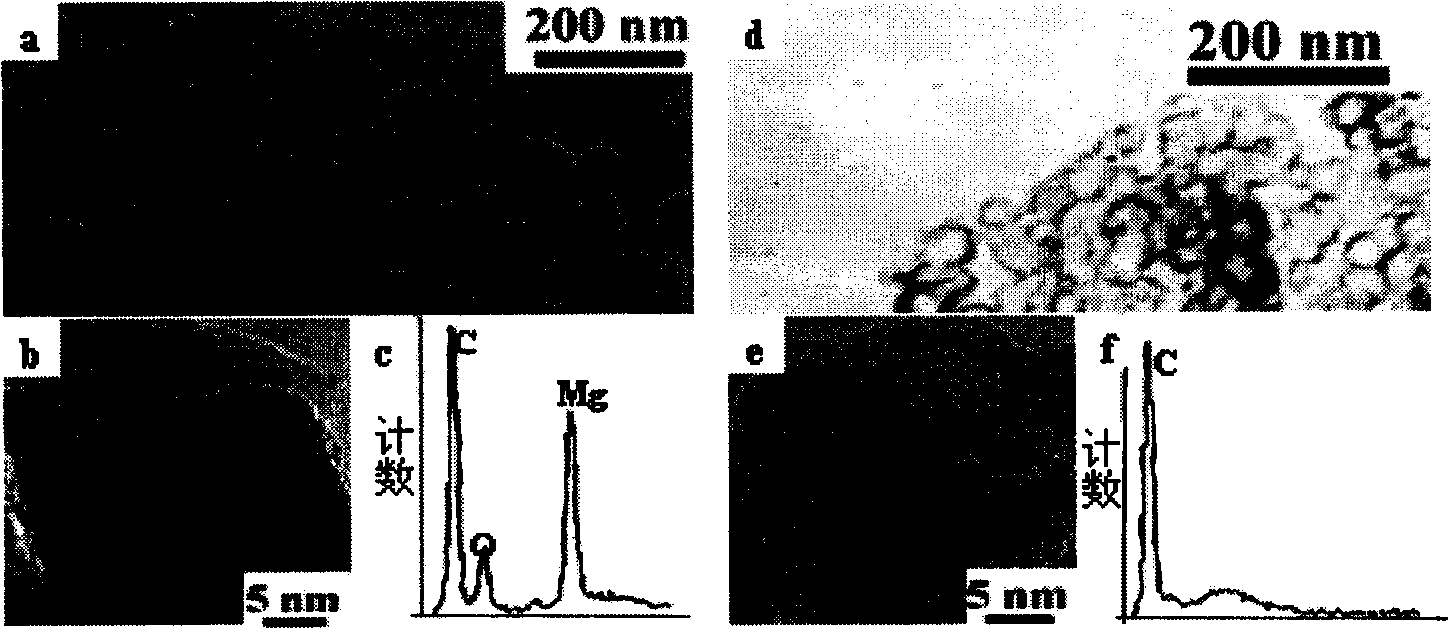Method for mass preparing hollow nano cages in high quality
A technology of carbon nanocage and hollow carbon, which is applied in the direction of nanotechnology, nanotechnology, nanostructure manufacturing, etc., can solve the problems of unfriendly reagents and toxic environment, and achieve the effect of low price, high purity, and easy recycling and reuse
- Summary
- Abstract
- Description
- Claims
- Application Information
AI Technical Summary
Problems solved by technology
Method used
Image
Examples
Embodiment 1
[0049] Example 1 Using benzene as a precursor, the reaction temperature is 670° C., and the reaction time is 60 minutes. Hollow carbon nanocages are prepared by in-situ template method.
[0050] Weigh a certain amount of basic magnesium carbonate and add it into the quartz tube, spread it evenly, put it into the central area of the tube furnace, then repeatedly fill it with argon and evacuate it with a mechanical pump for 3-5 times. Under an argon atmosphere (50 sccm), the temperature was raised to 670° C. at a rate of 10° C. per minute, benzene vapor was introduced by bubbling method, and the reaction was carried out for 60 minutes. After the reaction, the furnace tube was lowered to room temperature under the protection of argon (50 sccm), and the powder was collected from the quartz tube, soaked in 1mol / L dilute hydrochloric acid for 1 hour, filtered, washed repeatedly with deionized water until neutral, 110 °C drying to obtain hollow carbon nanocages. Specific surface a...
Embodiment 2
[0051] Example 2 Using benzene as a precursor, the reaction temperature is 690° C., and the reaction time is 60 minutes. Hollow carbon nanocages are prepared by in-situ template method.
[0052] Weigh a certain amount of basic magnesium carbonate and add it to the corundum tube, spread it evenly, put it into the central area of the tube furnace, and then repeatedly fill it with nitrogen and evacuate it with a mechanical pump for 3-5 times. Under a nitrogen atmosphere (50 sccm), the temperature was raised to 690° C. at a rate of 10° C. per minute, benzene vapor was introduced by bubbling, and the reaction was carried out for 60 minutes. After the reaction, the furnace tube was lowered to room temperature under the protection of nitrogen (50 sccm), and the powder was collected from the corundum tube, soaked in 0.1mol / L dilute hydrochloric acid for 12 hours, filtered, and washed repeatedly with deionized water until neutral, 110 °C drying to obtain hollow carbon nanocages. The...
Embodiment 3
[0053] Example 3 Using benzene as a precursor, the reaction temperature is 700° C., and the reaction time is 60 minutes. Hollow carbon nanocages are prepared by in-situ template method.
[0054] Weigh a certain amount of basic magnesium carbonate and add it into the ceramic tube, spread it evenly, put it into the central area of the tube furnace, then repeatedly fill it with argon and evacuate it with a mechanical pump for 3-5 times. Under an argon atmosphere (50 sccm), the temperature was raised to 700° C. at a rate of 10° C. per minute, benzene vapor was introduced by bubbling, and the reaction was carried out for 60 minutes. After the reaction, the furnace tube was lowered to room temperature under the protection of argon (50 sccm), and the powder was collected from the ceramic tube, soaked in 10mol / L hydrochloric acid for 5 minutes, filtered, and washed repeatedly with deionized water until neutral, at 110°C drying to obtain hollow carbon nanocages. (See image 3 , F...
PUM
| Property | Measurement | Unit |
|---|---|---|
| particle diameter | aaaaa | aaaaa |
| particle diameter | aaaaa | aaaaa |
| particle diameter | aaaaa | aaaaa |
Abstract
Description
Claims
Application Information
 Login to View More
Login to View More - R&D
- Intellectual Property
- Life Sciences
- Materials
- Tech Scout
- Unparalleled Data Quality
- Higher Quality Content
- 60% Fewer Hallucinations
Browse by: Latest US Patents, China's latest patents, Technical Efficacy Thesaurus, Application Domain, Technology Topic, Popular Technical Reports.
© 2025 PatSnap. All rights reserved.Legal|Privacy policy|Modern Slavery Act Transparency Statement|Sitemap|About US| Contact US: help@patsnap.com



